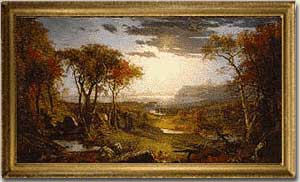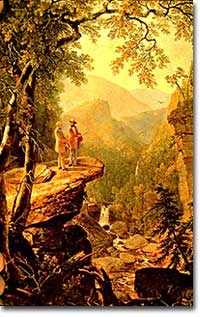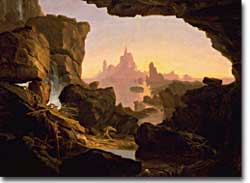26e. Hudson River School Artists

Jasper Cropsey was among the second generation of artists from the Hudson River School. His Autumn on the Hudson, 1860, exhibits his preference for landscape paintings with colorful foliage.
If you have a painting on the wall of your home today, it may be because of the influence of a group of painters known as the Hudson River artists. While not as individually famous as many other American painters of the 19th century, as a group they had an important contribution to make. Before the 1800's most artists were successful only if they could attract the notice of a wealthy family who could afford to have portraits painted. Artists not engaged in painting likenesses could be commissioned to recreate famous historical scenes to hang in the homes of the rich. But with the invention of the daguerreotype, a precursor to the photograph, it absorbed much of the demand for portrait painting. However, a new American school of landscape painting was about to emerge along with a new form of public entertainment — the art museum. Middle class people were about to become excited about art.

The artists of the Hudson River School were influenced less by European artists than by American artists and writers. Asher Durand's Kindred Spirits (1849) shows Thomas Cole and William Cullen Bryant, a poet of the age, discussing the beauty of nature.
Before 1830, there was no such thing as an art museum open to the public. Artists began to create work for the enjoyment of the Middle Class. Soon, it became as common to see a painting over the fireplace of a home as to find a Bible on the kitchen table. In 1839, the American Art Union was created to raise money for artists' salaries. At first, 814 members paid $5 a piece to join the union; a decade later, there were 19,000 members and $40,000 in payments to artists in a single year. One of these artists was the landscape painter, Thomas Cole.
Cole had no formal training as an artist. He could not draw a likeness, or any real figure for that matter. But he understood something his peers did not. While artists had been painting Americans for over a century, no one had painted America before — the mountains, streams, vistas, valleys, the limitless frontier. So nature became the subject of his canvas as America's national myth and new identity developed. Cole became the spiritual father of the wilderness landscape artists. His early subjects were the Hudson River Valley and the Catskill Mountains, full of beautiful scenery, waterfalls, and primal mists.

Thomas Cole's works, like The Subsiding of the Waters of the Deluge (1829), inspired his contemporaries as well as future American artists.
Thus was a bold style of "native" American art created. Other landscape painters such as Asher Brown Durand and Fitzhugh Lane, and the panoramists Frederick Edwin Church and Albert Bierstadt put on canvas not just the areas around upper New York State but also the diversity of beauty found in the far west, the Sierra Mountains, the Rockies, Latin America, and Mexico. They tried to express a love of nature and a feeling for man's place in it. At the same time, culture was becoming the province of all people not just a wealthy elite. Thus, as foreigners looked on in amazement, the Hudson River artists left European tastes behind and began to paint the magical beauty and awesome power of nature in America with extraordinary success.






